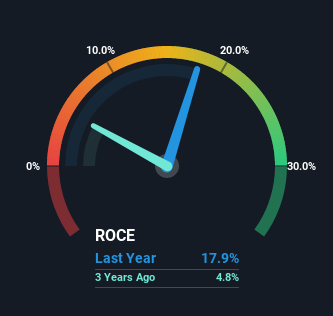- France
- /
- Medical Equipment
- /
- ENXTPA:ALBIO
Returns On Capital Are Showing Encouraging Signs At Biosynex (EPA:ALBIO)

What trends should we look for it we want to identify stocks that can multiply in value over the long term? Firstly, we'd want to identify a growing return on capital employed (ROCE) and then alongside that, an ever-increasing base of capital employed. Put simply, these types of businesses are compounding machines, meaning they are continually reinvesting their earnings at ever-higher rates of return. With that in mind, we've noticed some promising trends at Biosynex (EPA:ALBIO) so let's look a bit deeper.
Return On Capital Employed (ROCE): What Is It?
If you haven't worked with ROCE before, it measures the 'return' (pre-tax profit) a company generates from capital employed in its business. To calculate this metric for Biosynex, this is the formula:
Return on Capital Employed = Earnings Before Interest and Tax (EBIT) ÷ (Total Assets - Current Liabilities)
0.18 = €39m ÷ (€250m - €31m) (Based on the trailing twelve months to December 2022).
Thus, Biosynex has an ROCE of 18%. In absolute terms, that's a satisfactory return, but compared to the Medical Equipment industry average of 2.9% it's much better.
Check out our latest analysis for Biosynex

While the past is not representative of the future, it can be helpful to know how a company has performed historically, which is why we have this chart above. If you're interested in investigating Biosynex's past further, check out this free graph of past earnings, revenue and cash flow.
SWOT Analysis for Biosynex
- Debt is not viewed as a risk.
- Dividend is in the top 25% of dividend payers in the market.
- Earnings declined over the past year.
- Trading below our estimate of fair value by more than 20%.
- Lack of analyst coverage makes it difficult to determine ALBIO's earnings prospects.
- No apparent threats visible for ALBIO.
What Can We Tell From Biosynex's ROCE Trend?
We like the trends that we're seeing from Biosynex. The data shows that returns on capital have increased substantially over the last five years to 18%. The company is effectively making more money per dollar of capital used, and it's worth noting that the amount of capital has increased too, by 630%. This can indicate that there's plenty of opportunities to invest capital internally and at ever higher rates, a combination that's common among multi-baggers.
In another part of our analysis, we noticed that the company's ratio of current liabilities to total assets decreased to 12%, which broadly means the business is relying less on its suppliers or short-term creditors to fund its operations. So shareholders would be pleased that the growth in returns has mostly come from underlying business performance.
Our Take On Biosynex's ROCE
All in all, it's terrific to see that Biosynex is reaping the rewards from prior investments and is growing its capital base. Since the stock has returned a staggering 174% to shareholders over the last five years, it looks like investors are recognizing these changes. In light of that, we think it's worth looking further into this stock because if Biosynex can keep these trends up, it could have a bright future ahead.
Biosynex does have some risks though, and we've spotted 5 warning signs for Biosynex that you might be interested in.
If you want to search for solid companies with great earnings, check out this free list of companies with good balance sheets and impressive returns on equity.
Valuation is complex, but we're here to simplify it.
Discover if Biosynex might be undervalued or overvalued with our detailed analysis, featuring fair value estimates, potential risks, dividends, insider trades, and its financial condition.
Access Free AnalysisHave feedback on this article? Concerned about the content? Get in touch with us directly. Alternatively, email editorial-team (at) simplywallst.com.
This article by Simply Wall St is general in nature. We provide commentary based on historical data and analyst forecasts only using an unbiased methodology and our articles are not intended to be financial advice. It does not constitute a recommendation to buy or sell any stock, and does not take account of your objectives, or your financial situation. We aim to bring you long-term focused analysis driven by fundamental data. Note that our analysis may not factor in the latest price-sensitive company announcements or qualitative material. Simply Wall St has no position in any stocks mentioned.
About ENXTPA:ALBIO
Biosynex
Designs, manufactures, and distributes rapid diagnostic tests in France and internationally.
Moderate and slightly overvalued.
Market Insights
Community Narratives





